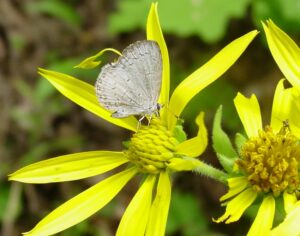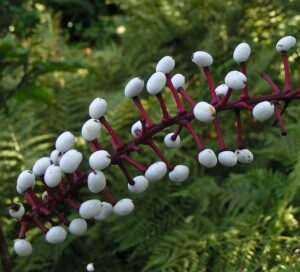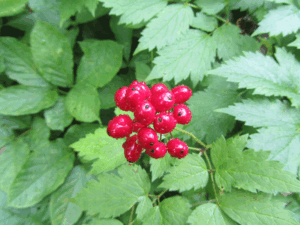
Black Cohosh and Doll’s Eyes–Tall, Shade-loving, and Native
Black cohosh (Actaea racemosa) was used by Native Americans as an herbal remedy and its popularity continues to this day. This plant is native to eastern North America and is found throughout Virginia except for the outer coastal plain. It grows in a variety of woodland habitats, and is often found in small woodland openings. If you are not interested in growing this native for its medicinal properties (and PMG is not endorsing its use), is it still an excellent addition for your shade garden? If you are looking for a plant with dramatic flair, the answer is a resounding “Yes!” Before we consider its ornamental value, let’s quickly address its use in herbal medicine.
MEDICINAL PROPERTIES
Black cohosh is a member of the buttercup family (Ranunculaceae). Other names for this rhizomatous forest herb include snakeroot, black bugbane, rattleweed, macrotys, and rheumatism weed. It is reputed to have analgesic, sedative, and anti-inflammatory properties. Native American and Chinese herbalists have traditionally used black cohosh root for a variety of ailments, and as an insect repellent. This last property is responsible for the common name, bugbane. Currently, people use black cohosh as a dietary supplement for hot flashes and other menopausal symptoms. In 2014 consumers in the U.S. spent about $60 million on black cohosh supplements. Black cohosh contains potent phytochemicals that have an effect on the endocrine system. How it works is not yet clear. Further research is needed to assess its effectiveness as well as its long-term safety. Possible liver damage is one side effect that is under study. For more information on black cohosh studies, see the Source list at the end of this article.
ORNAMENTAL CHARACTERISTICS
Black cohosh offers a combination of ornamental characteristics that is both prized and difficult to find:
- a total height (foliage plus flowering spikes) of 4-6’
- shade loving
- striking white blooms in late summer
- attractive deep-green, coarsely-serrated leaves, similar in appearance to astilbe foliage
- deer resistance
- native to eastern North America
BLOOM
Black cohosh has small, numerous, creamy white flowers that appear in terminal inflorescences up to one meter long. With stem height, the blooms extend up to 2 meters in height, rising on wiry stems well above the foliage in late summer. Flowering commences at the bottom of each raceme and progresses apically (toward the tip). The long white inflorescences arch gracefully, lighting up the shady forest.
A few years ago while hiking on Humpback Rocks (Milepost 5.8, Blue Ridge Parkway), we came across a stand of black cohosh in peak bloom, which inspired me to add this plant to our shade garden. The plant’s height makes it a standout architectural plant at the back of the garden. Although most impressive when planted in groups, the plant can also add drama as a solo specimen plant.
CULTIVATION
Cultivation is easy if growing requirements are met: medium-to-deep shade, rich humusy soil, and adequate moisture. Leaf margins may brown (scorch) and growth may slow if soils are not kept consistently moist. Foliage generally does not need staking, but taller flower spires may need some support. Plants can be cut back to the ground in late fall to tidy the garden, if desired, but is not necessary.
PROPAGATION
Cohosh comes from an Algonquin word meaning rough in reference to the appearance of plant rhizomes. Plants can be propagated by rhizome division or by seed. To germinate, seeds require exposure first to warm temperatures and then to cold. Ripe seeds can be sown directly outdoors. Be aware that it may take years before plants reach flowering size. In the nursery trade, two varieties are usually available: dissecta, with deeply-cut leaflets, and cordifolia, with shallowly-lobed leaflets resembling maple leaves.
POLLINATOR HOST
Flowers emit a sweet/fetid odor that attracts carrion-eating pollinating flies, gnats, beetles, and bumblebees seeking pollen and nectar. The plant is host for the Appalachian azure butterfly (Celastrina neglectamajor). Caterpillars feed exclusively on black cohosh flowers; adults feed on flower nectar. Unfortunately, black cohosh is being forced out in some woodland areas by the nonnative invasive, garlic mustard (Alliaria petiolata). More information is needed on this threat.
PESTS AND DISEASES
Black cohosh has no serious insect or disease problems. Rust and leaf spot are occasional problems.
SIMILAR PLANT – DOLL’S EYES
Black cohosh is closely related to doll’s eyes, also commonly called white baneberry (Actaea pachypoda). These two native perennials share similar characteristics and are difficult to distinguish based on foliage early in the season. As the season progresses, distinguishing characteristics emerge.
Doll’s eyes typically grows to 30” tall and is primarily cultivated in woodland and shade gardens for its attractive white berries and astilbe-like foliage. It naturally occurs in deep woods, north-facing wooded slopes, bluff bases, and ravines.
BLOOM
In spring, tiny white flowers appear in short, oblong terminal clusters atop long greenish stems rising above the foliage. The flowers lack nectar and provide only pollen to visiting insects. These visitors are mainly Halictid bees. Flowering stems thicken after bloom and turn an attractive red, as pea-sized white berries develop in summer in elongated clusters.
BERRIES
The berries are extremely poisonous if eaten, hence the common name of baneberry. Baneberry is the common name for several species of plants in the genus Actaea. This group in the buttercup family (Ranunculaceae) has toxic fleshy berries, hence the name “bane” meaning something that causes death or a deadly poison. Each doll’s eye berry has a distinctive small dark purplish spot (formed by the flower stigma) which is thought to resemble the eyes of old-fashioned china dolls, hence the common name. Berry toxicity is likely the main reason that wildlife seems to ignore the fruit, although birds seem to be immune to the toxins. Many species of native birds actually thrive on the plant. Such birds include the Ruffed Grouse, Yellow-Bellied Sapsucker, and American Robin. The White-Footed Mouse also eats the berries. Because the foliage is toxic from a cardiac glycoside, it is not eaten by mammalian herbivores.
PROPAGATION
Self-seeding may occur in optimum growing conditions where the berries fall to the ground. If naturalization is desired, berries may be picked and immediately planted into the ground as soon as they ripen in the fall in order to promote colonial spread. It typically takes 2 or more years for seeds to germinate under natural conditions. Baneberry can also be propagated by division in early spring. Plants are slow growing and take a few years to grow large enough to flower.
DIFFERENCES BETWEEN THE TWO SPECIES
In summary, A. racemosa and A. pachypoda share similar physical characteristics and are difficult to distinguish based on foliage early in the season. After flowering, there are distinctive differences:
- A. racemosa can reach a much greater height (at least twice as tall).
- The terminal inflorescenses of racemosa are up to 12” long while the terminal clusters of A. pachypoda are cylindrical and much shorter.
- A. racemosa produces both pollen and nectar; A pachypoda produces only pollen.
- A. racemosa blooms in late summer; A. pachypoda blooms in spring (May to June).
- The stems of A. pachypoda turn red after the plant has bloomed.
- A. racemosa has dried fruits; A. pachypoda has fleshy berries.
- The white berries of A. pachypoda extend from the stem on thick, reddish stalks from July to October.
- The berries and all parts of A. pachypoda are very poisonous to people and mammals, although birds seem to be immune to the toxin.
- The roots and rhizomes of A. racemosa are used for making dietary supplements for post-menopausal symptoms and other illnesses.
RED BANEBERRY
There is also a red-fruited form of this species, red baneberry (A. rubra), distinguished by its thick floral stalk. Growing in bushy clumps, red baneberry bears fluffy clusters of small white flowers in spring. The berries that ensue in mid-to-late summer are brilliant red, though sometimes white, with a very small black dot at the end of the berry. This dot is less noticeable than the dot on the white berries of doll’s eyes. The leaves are alternate, compound, toothed, and more dissected than the leaves of doll’s eyes. All parts of baneberry plants, including the berries, are poisonous and should never be eaten. Red baneberry’s natural habitat reaches its southern limits in New Jersey, Indiana, Iowa, and Kansas.
SUMMARY
Black cohosh brightens a shade garden with white flowers that appear on gracefully arching white terminal inflorescences up to a meter long. When massed at the back of the garden, the plant’s height and large astilbe-like foliage adds a strong architectural definition. It is the host plant for the Appalachian azure butterfly (Celastrina neglectamajor). Black cohosh’s position in the forest under-story, and its role as a food source for the Appalachian azure, is threatened by the nonnative invasive plant, garlic mustard (Alliaria petiolata). Doll’s eyes offers many of the same ornamental characteristics as Black cohosh, with the addition of attractive but highly toxic white berries.
SOURCES
“Herbs at a Glance: Black Cohosh,” National Institute of Health, National Center for Complementary and Integrative Health, https://nccih.nih.gov/health/blackcohosh/ataglance.htm
Black Cohosh, National Institutes of Health, Office of Dietary Supplements, https://ods.od.nih.gov/factsheets/BlackCohosh-HealthProfessional/
“The Truth About Black Cohosh Supplements for Menopause,” Consumer Reports,February 19, 2016, https://www.consumerreports.org/vitamins-supplements/the-truth-about-black-cohosh-supplements-for-menopause/
“Black Cohosh for Menopause Symptoms,” Michigan Medicine, University of Michigan, https://www.uofmhealth.org/health-library/tn9522
“Wildflower of the Year Actaea racemosa,” Black Cohosh, Virginia Native Plant Society, https://vnps.org/wildflowers-of-the-year/wildflower-of-the-year-2017-actea-racemosa-black-cohosh-2/
Actaea racemosa, Missouri Botanical Garden Plant Finder, http://www.missouribotanicalgarden.org/PlantFinder/PlantFinderDetails.aspx?kempercode=j790
Appalachian azure, Butterflies and Moths of North America, https://www.butterfliesandmoths.org/species/Celastrina-neglectamajor
Appalachian azure, New York Natural Heritage Program, https://guides.nynhp.org/appalachian-azure/
Black Cohosh, Illinois Wildflowers, https://www.illinoiswildflowers.info/woodland/plants/black_cohosh.htm
Doll’s Eyes, Illinois Wildflowers, https://www.illinoiswildflowers.info/woodland/plants/doll_eyes.htm
Actaea pachypoda, Missouri Botanical Garden Plant Finder, missouribotanicalgarden.org/PlantFinder/PlantFinderDetails.aspx?kempercode=h520
“Baneberry, Actaea spp.,” Master Gardener Program Division of Extension, University of Wisconsin-Madison, https://wimastergardener.org/article/baneberry-actaea-spp/
Actaea pachypoda, NC State Extension, https://plants.ces.ncsu.edu/plants/all/actaea-pachypoda/
Actaea racemosa, NC State Extension, https://plants.ces.ncsu.edu/plants/all/cimicifuga-racemosa/
Actaea pachypoda, USDA Plants Database, https://plants.usda.gov/core/profile?symbol=ACPA
Actaea rubra, USDA Fire Effects Information System (FEIS), https://www.fs.fed.us/database/feis/plants/forb/actrub/all.html
Red baneberry, Acteae rubra, Ontario Wildflowers, http://ontariowildflowers.com/main/species.php?id=18




